Common menu bar links
Awareness guide - extremist groups
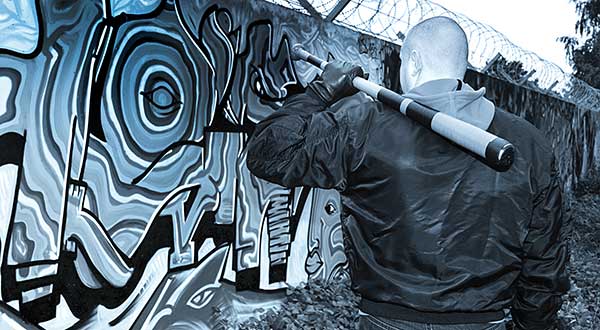
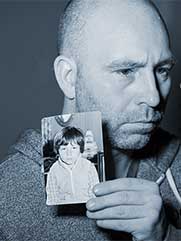
"My childhood is a story of violence. Beatings, brutality, abuse, from as far as I can remember violence is what I was taught. I grew up trying to do the only thing I knew and identified with; I had been so deeply wounded. Violence is now part of the past and I do everything I can to stay away from it. Unfortunately, I cannot forget."
Daniel Gallant
Ex-member of a supremacy group, now Juris Doctor (Law) Candidate (2017), but also social worker, writer, researcher and EXIT Canada director working to combat any form of violence.
This section of the guide identifies the leading national and international extremist groups, organizations, movements and symbols. They fall into three main categories: extremist right-wing groups, extremist left-wing groups and groups driven by a single motivation.
A/ Right-wing Extremism
1. Groups, organizations and ideologies
Right-wing extremism can be defined as the various movements that either by tradition, patriotism, nationalism, fascism, or adhesion to a counter-revolutionary ideology, are hostile to both the socialist and liberal conceptions of society. A significant number of extreme right groups have been observed in Canada over the years; however, it is important to understand that these groups have few members and that the members often change groups or belong to several groups at the same time. When new groups are created, it does not necessarily mean that new members join the movement. Extreme right groups, often led by charismatic leaders, can be short-lived or serve as facades. Rightwing extremism encompasses a large, loose, heterogeneous collection of groups and individuals espousing a wide range of grievances and positions; these groups can sometimes be in conflict with each other.
In general, members of extreme right groups are proud of the ideology behind their movement and tend to keep a high profile.
References
- Canada Security Intelligence Review Committee. The Heritage Front affair: report to the Solicitor General of Canada, Ottawa, 1994.
- Barrett, Stanley R. Is God a Racist? The Right Wing in Canada, Toronto, University of Toronto Press, p. 40, 1987.
- Ellis, James O. and Richard Parent. Right-Wing Extremism in Canada. TSAS Working Paper, 2014.
- Ross, Jeffrey Ian. Contemporary Radical Right-Wing Violence in Canada: A Quantitative Analysis in Terrorism and Political Violence, Vol. 4, No. 3, 1992.
- Ku Klux Klan
- Church of the Creator
- Heritage Front (HF)
- Blood & Honour
- Combat 18 (C18)
- Golden Dawn
- Hammerskins Nation
- Aryan Guard
- Skinhead Movement
Ku Klux Klan
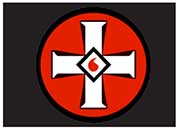
Ku Klux Klan symbol
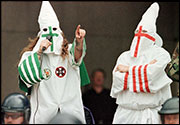
The Grand Dragon of the Michigan Klu Klux Klan
Date of creation
1865
Founder
A group of ex-officers of the U.S. Confederate Army
Classification
White supremacist, religious
Description
The Ku Klux Klan, a white protestant supremacist organization commonly called the Klan or KKK, was created after the civil war in the United States. It is considered as the ‘granddaddy’ of the right-wing extremist movement. The name of the organization is derived from the Greek word kuklos, which translates to English as "circle". The group changed the Greek word slightly to kuklux and added the word klan to note the Scottish heritage of the group’s first members. Today, the KKK is a marginalized organization, replaced by neo-Nazi groups. In Canada, the KKK has long been a concern for the security services mainly because of its paramilitary tendencies. It held training camps and its objective was clearly related to racial war. While the Ku Klux Klan has almost disappeared, its symbolic significance remains considerable.
Illegal or violent activities
In the United States, members of the KKK have been charged with violent crimes and murder. In Canada, the KKK is mostly known for their acts of intimidation and racist incidents: violence, letters of threat, burning crosses to scare their detractors and demonstrations against immigrants, Asians, Catholics and French-speaking people. Some members have been involved in homicides or attempted murders.
In 1987, two men pleaded guilty in Alberta for their involvement in a KKK conspiracy to bomb a Jewish centre in Calgary and kill a Jewish businessman. Their objective was to increase tensions between the Jewish and Arab communities. In 1991, an Aboriginal man was murdered in Saskatchewan by a leader of the Ku Klux Klan in Canada. The same year, a man was beaten, stoned and thrown in a river in Winnipeg because he was homosexual. At least one of the four murderers was a member of the KKK.
Specific symbols
The members of the KKK wear a distinctive white costume: a robe and pointed hat that only shows the eyes. One of their well-known intimidation tactics is to burn giant wood crosses in public locations. The group also uses the confederate flag and the Celtic cross as their symbols.
References
- Baysinger, Timothy G. Right-Wing Group Characteristics and Ideology, Naval Postgraduate School Monterey, Center for Homeland Defense and Security, 2006.
- Dictionnaire Larousse - Ku_Klux_Klan
- Sher, Julian. White Hoods: Canada's Ku Klux Klan, Vancouver, New Star Books, 1983.
- Reuters. Two Canadians sentenced to five years in Ku Klux Klan plot, 1989.
- Bourgeault, Ron. The Killing of Leo LaChance, Canadian Dimension, Vol. 28, No. 2, 1994.
Church of the Creator
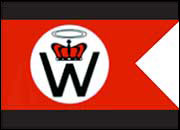
The Church of the Creator logo
Date of creation
1973
Founder
Ben Klassen
Classification
White supremacist, completely rejects Christianity
Description
The organization describes itself as a religion, the white race’s religion. This complex doctrine is called "Creativity". It was designed with the idea that Odinism (a Viking religion) and the Christian identity were completely lost. The ideology of the group is based on Racial Holy War (RaHoWa), a name also given to the musical group of one of its historic leaders.
Illegal or violent activities
In the United States, the group is considered to be extremely violent. The members are responsible for several murders and openly call for violence. In Canada, the group took part in confrontations related to musical events. The then leader, George Burdi, was found guilty of kicking a female left-wing militant in the face during a concert.
Specific symbols
The group has a red and black flag featuring a large "W", a crown and a halo in a white circle. The members have tattoos or ostentatious items with "RAHOWA" written on them.
Reference
- Ellis, James O. and Richard Parent. Right-Wing Extremism in Canada, TSAS Working Paper, 2014.
Heritage Front (HF)
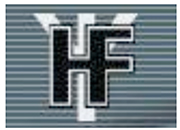
Heritage Front logo
Date of creation
1989
Founder
Wolfgang Droege
Classification
White supremacist, nationalist
Description
The year the Heritage Front (HF) was created, some of its members traveled to Tripoli to celebrate the 20th anniversary of the Libyan revolution. The Libyan President, Muammar Gaddafi, funded left and right wing groups that shared his anti-Jewish, anti-capitalist and anti-communist vision. Extreme right groups in need of funds and support easily forged ties with the regime. A few years later, HF became the most important advocate of white supremacy in Canada.
The group had two branches: political and military. The Heritage Front was allied to The Church of the Creator. It is no longer active today.
Illegal or violent activities
Some members of the HF participated in violent confrontations along with members of The Church of the Creator, while several members belonged to both groups. Events of violence were attributed to the group, such as the attack on a Vietnamese shopkeeper in Toronto in 1989 and on a Tamil refugee in 1993.
Specific symbols
The sign of the group consists of the letters "HF". The life rune, in the background, refers to the spiritual dimensions of protection and honour. It was used in different contexts by the Nazis and was appropriated by many white supremacist groups.
Reference
- Canada Security Intelligence Review Committee. The Heritage Front affair: report to the Solicitor General of Canada, Ottawa, 1994.
Blood & Honour
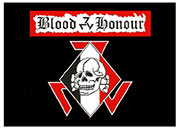
Blood & Honour Symbol
Date of creation
1987
Founder
Ian Stuart Donaldson
Classification
Anti-communist, neo-Nazi, nationalist, white supremacist
Description
Blood & Honour is known as a network for the promotion of neo-Nazi music. The name Blood & Honour is the same as the slogan of the Hitler Youth, "Blut und Ehre" (Blood and Honour). The founder of the group, Ian Stuart Donaldson, was the singer and leader of the extreme right British rock band Skrewdriver advocating neo-Nazi convictions. Ian Stuart Donaldson died in 1993 but is still revered by the organization. Blood & Honour publishes an eponym magazine promoting neo-Nazism through interviews with extreme right musical groups and the promotion of concerts featuring White power musical groups.
Blood & Honour has several official divisions in approximately twenty countries, including Great-Britain, the United States, Italy, Belgium, France and Spain. In Canada, the group is present in Quebec, Ontario and Alberta.
Illegal or violent activities
The various divisions of Blood & Honour organize concerts and white pride rallies that bring together skinheads and other neo-Nazi supporters. Many acts of violence are attributed to members affiliated to the group. For example, in 2012, in British-Columbia, two members were charged with hate crime and aggravated assault against a citizen of Filipino origin.
Specific symbols
In addition to the symbols identified to Blood & Honour such as the triskele made up of three 7s and the words "Blood & Honour", other symbols of the Nazi era are also used: flag, swastika and skull. The members of the organization also use other white supremacy symbols such as the United States Confederate flag (American Civil War), the Celtic cross and the old South African flag (from the Apartheid era). They use photos of white supremacists killed for the cause and a variety of symbols of the group Combat 18, the armed and radical branch of Blood & Honour.
Reference
Combat 18 (C18)

Combat 18 symbol
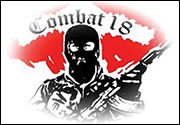
Combat 18 illustration
Date of creation
1991
Founder
Charlie Sargent
Classification
Neo-Nazi, white supremacist
Description
Combat 18 is the armed and radical branch of Blood & Honour. The movement is present internationally. The number 18 refers to the letters A and H, the initials of Adolf Hitler. Combat 18 is a neo-Nazi organization advocating white supremacy, anti-Semitism and islamophobia. It has long been associated with loyalist terrorist organizations in Northern Ireland. Combat 18 is present in various countries, including Great-Britain, Italy, South Africa, Argentina, Belgium, Germany, Russia, Serbia, Denmark, Sweden, Austria, the United States and Canada.
Illegal or violent activities
Combat 18 is known for its violent actions, including murder and bombing. In Great-Britain, several members including active soldiers were charged with acts of violence. In 2010, three Australian activists were charged in relation to an armed attack against a mosque.
Specific symbols
The members of the group use the same symbols as Blood & Honour. However, an important place is given to weapons in the symbols and public appearances.
References
- Independent.co.uk - Combat 18: Memoirs of a street-fighting man
- Schweizer, Daniel (director). Skinhead Attitude [documentary], Switzerland, 2003.
- Perth Now - Alleged Combat 18 members in court over mosque shooting
Golden Dawn
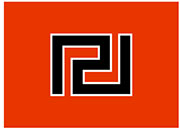
Golden Dawn flag
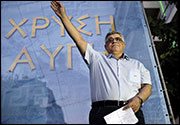
Nikós Michaloliákos, leader of the Greek political party Golden Dawn in 2012

Athens, Greece: Activists from the Golden Dawn
Date of creation
1993
Founder
Nikós Michaloliákos
Classification
Neo-Nazi, xenophobic
Description
Golden Dawn is a Greek radical, far-right neo-Nazi political party created in 1993. The founder, Nikós Michaloliákos, openly denied the existence of the crematory ovens and gas chambers in Nazi concentration camps during the Second World War. Despite the arrest of many of its supporters, the party won 17 seats in the Greek election of 2014.
Present in Canada since 2012, Golden Dawn has two chapters, one in Montréal and one in Toronto. The objective proclaimed by these chapters is to provide support and assistance to Greek-born citizens.
Illegal or violent activities
In September 2013, in Greece, the party leader and five other parliamentarians were arrested and charged with participation in a criminal organization. It was alleged that they were responsible for the murder of a far-left activist. Thirteen other activists and two police officers were also arrested. It should be noted that, to date, the group has never committed any illicit act in Canada.
Specific symbols
The group sometimes uses the Celtic cross as a symbol. It also has a red flag and uses messages written in Greek.
Reference
HAMMERSKINS NATION

Symbol of the group Hammerskins Nation
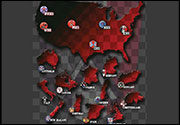
Hammerskins Nation 14 chapters, including one in Canada
Date of creation
1988
Founder
Sean Tarrant
Classification
Racist, white supremacist
Description
The Hammerskins Nation was created in 1988 in Texas. It has 14 chapters in America and Europe. The organization has no leader, but rather relies on the autonomy and loyalty of its adherents.
In Canada, the group is represented under the name Vinland Hammerskins, a group originating from Montréal. Drawing on an ideology advocating white supremacy, this group, essentially composed of racist right-wing skinheads, is characterized by the violence and extremism of its actions. The Hammerskins Nation is the most feared and respected of the racist skinhead groups in the United States.
Illegal or violent activities
The Canadian members of the group engage in significant violence, even outside Canada. In one case, three young Canadians affiliated to the Hammerskins Nation were found guilty of the murder of an Afro-American man in Texas in 1993.
Specific symbols
Supporters of the Hammerskins Nation use The Wall video clip by Pink Floyd as a model. In this video clip, two hammers symbolize fascism. The Hammerskins Nation supporters also use various Nazi symbols as well as photos of "martyrs", representing members who were killed. The members cross their arms to represent the two hammers and some also have hammers tattooed on their forearms. This also refers to the sign used by a fictive fascist society in the movie "1984" based on the novel by George Orwell.
Reference
Aryan Guard
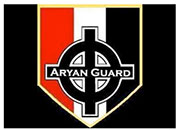
Aryan Guard Symbol
Date of creation
2006
Founder
Kyle Mckee
Classification
Neo-Nazi, white supremacist
Description
The Aryan Guard was created in Calgary, Alberta. The group claims to be the new version of white supremacy, more present and visible. The group has participated in demonstrations and organized its own marches from the very beginning. The leader occupies a central position and is even called the "micro-fuhrer". He and his group attract individuals who will travel to Calgary to participate in their activities.
Illegal or violent activities
Some members were charged with various acts of violence, assault causing bodily arm and making explosives. The National-Socialist Party of Canada (NSPC), a non-registered political party, had ties with the Aryan Guard. The NSPC leader, Terry Tremaine, who was invited to attend conferences organized by the Aryan Guard, was sentenced to 30 days in jail for acting in contempt of an order of the Canadian Human Rights Tribunal and was ordered to remove racist postings on websites.
Specific symbols
The group often uses the Celtic cross and the words "White Pride, Worldwide" either on tattoos or on their flag. The swastika is also one of their symbols.
References
- Vice.com - A New Look at Calgary's Neo-Nazi Movement
- TheGlobeandMail.com - Calgary's in-your-face neo-Nazis take to the streets
- TorontoSun.com - White power fizzles as Aryan Guard calls it quits
Skinhead Movement

Skinhead movement logo
Date of creation
1970-1980
Founder
Unknown
Classification
Neo-Nazi, white supremacist, xenophobic
Description
The skinhead movement or sub-culture started in the United Kingdom within the working class. It has several variants, including the neo-Nazi extreme right movement and an extreme left variant (group SHARP) claiming to be antiracist and non-political. Racist right-wing skinheads are well-established in Canada. While some groups and individuals are independent, white supremacy music plays an important role in this movement.
In the late 1970s and early 1980s, the first skinheads appeared in major cities in Canada (Montréal, Vancouver, Toronto and Calgary). First seen in urban areas, the movement progressively spread to small towns and rural areas. At first, it was based more on "neo-Nazi folklore" than an outright ideology. It developed into something ideologically structured when extreme right groups started recruiting within the movement. The international skinhead culture, particularly through its music, is at the root of a clear ideology and receptivity to right-wing extremism among youth in Canada. The movement includes, or included, various organizations such as Longitude 74, the White Federation, the Aryan Resistance Movement (ARM), United Skinheads of Montreal, although most members do not have any allegiance to a formal organization. A significant number of skinheads are part of extreme right groups that are not exclusive to this sub-culture. For example, groups such as the Aryan Nations and White Aryan Resistance, that are more popular in the United States, have welcomed many members of this sub-culture. The extreme right skinheads are called "boneheads" by the left wing, in reference to their shaved heads. They use Internet sites to recruit and spread their ideology. However, they prefer personal contacts to recruit and advertise their fundraising concerts.
Illegal or violent activities
Skinheads are considered as the "soldiers" of the white supremacist movement. The violence used by the movement is mainly expressed at concerts and demonstrations. Skinheads are also responsible for actions perpetrated against individuals or symbolic sites, such as mosques.
Racist crimes are an integral part of the skinhead movement’s history and also serve as initiation rites. However, other types of crime and violence are identified every year, including altercations between gangs and crimes perpetrated for no apparent reasons.
Specific symbols
The most common signs used by this extreme right movement are the Celtic cross and the swastika, in addition to various numbers associated to right-wing extremism. Shaved or very short hair, sweaters featuring the names of extreme right groups or racist messages, bomber jackets, jeans, suspenders, combat pants and boots characterize the physical appearance of the followers of this movement. The colour of the suspenders and boot laces can also be indicative of whether the group is racist or not, or indicate the position of the member in the organization. However, the colours are different for each group and area.
Adherents to the extreme left movement Skinhead Against Racial Prejudice also wear military type clothing and the crushed swastika symbol or the SHARP logo. They do not shave their heads completely.
References
- Ellis, James O. and Richard Parent. Right-Wing Extremism in Canada, TSAS Working Paper, 2014.
- Young, Kevin and Laura Craig. Beyond White Pride: Identity, Meaning and Contradiction in the Canadian Skinhead Subculture, Canadian review of sociology and Anthropology, Vol. 34, No. 2, 1997.
- Hubert, Daniel and Yves Claudé. Les Skinheads et l'extrême droite, Montréal, VLB, 1991.
- Campana, Aurélie and Samuel Tanner. The Process of Radicalization: Right-Wing Skinheads in Quebec, TSAS Working Paper, 2014.
2. Books, symbols, numbers and letters associated to right-wing extremism
A variety of books, symbols, numbers and letters taken from the extreme right ideology are used to identify affiliation to a group. These may appear on clothes, tattoos and graffiti. Particular nonverbal gestures may also suggest an association to a group such as the Nazi salute or indicating specific numbers with fingers.
- The Turner Diaries
- Mein Kampf
- White Fist or Aryan Fist
- Celtic Cross
- Swastika
- The Odal rune
- Totenkopf
- 14/88
- 4/20
- 23
- Rahowa
The Turner Diaries
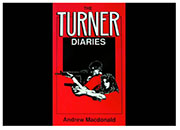
The Turner Diaries book cover
Date of creation
1978
Classification
White supremacist
Description
The Turner Diaries is not considered a significant symbol, but it holds an important place in right-wing extremism and among rightwing adherents. The sci-fi novel was written by William Pierce, the founder of the National Alliance, a very important extreme right group in the United States. It depicts a violent revolution in the United States that results in the overthrow of the federal government and a racial war against Jews, homosexuals and non-Whites.
This particularly violent story is read by members of the extreme right worldwide and influences some of them in their doctrines and actions.
Mein Kampf
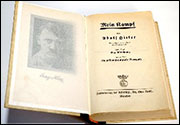
Adolf Hitler’s book, Mein Kampf
Date of creation
Between 1924 and 1925
Classification
Nazi
Description
This book was written by Adolf Hitler while he was incarcerated in Landsberg prison. This autobiography outlines racist theories and the premise of the Nazi movement. It is legally sold in Canada and is a source of inspiration for many white supremacists, especially neo-Nazis. It is also a source of veneration for many followers of Adolf Hitler’s movement and ideology.
White Fist or Aryan Fist
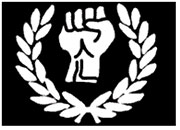
White Fist logo
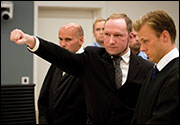
Extreme right-wing terrorist, Anders Breivik, giving a salute at his trial in 2012 for killing 77 people and injuring 151.
Date of creation
Unknown
Classification
White supremacist
Description
The White Power proposes the White Fist, or Aryan Fist, as a symbol of the fight of Aryan people for their survival.
The White Power doctrine is associated to the neo-Nazi movement that seeks hegemony using violence as a means of coercion. The White Power doctrine is the fundamental ideological source motivating the actions of extreme right-wing skinhead groups. This ideology has spread everywhere in the world where there are white people. The White Fist is a response to the symbol of the raised fist used by the Black Power movement.
Celtic Cross

Celtic Cross
Date of creation
Early 8th century
Classification
Racist, nationalist
Description
The Celtic cross is a common symbol in Ireland and Great-Britain. It is generally associated to Celtic communities. The Celtic cross was appropriated by various nationalist movements.
The Celtic cross is often used by right-wing extremists to symbolize the White Power, among other things.
Swastika

Swastika
Date of creation
1920
Classification
Nazi, neo-Nazi
Description
The swastika is the official emblem of the Nazi ideology. It is still popular today with the resurgence of the neo-Nazi movement worldwide. However, it should be noted that different groups try to use derivative or less ostentatious symbols to avoid attracting attention and circumvent the laws in countries where the use of certain images or Nazi representations is prohibited.
The swastika is very important in Hinduism and Buddhist cultures, but does not have a negative connotation.
The Odal rune

The Odal rune

"Wiking Jugend", a German neo-Nazi organization illegal since 1994. The organization used the Odal rune as a symbol.
Date of creation
1933 (start of the 3rd Reich)
Classification
Nazi, neo-Nazi
Description
The signification of the Odal rune for the neo-Nazis goes back to the beginning of the Proto-Germanic era where it meant "heritage". This symbol was appropriated by Adolf Hitler during the Second World War. Under the 3rd Reich, the Odal rune was the symbol of the 7th SS Volunteer Mountain Division Prinz Eugen and also represented the paramilitary organization Hitlerjugend (Hitler Youth). After the Second World War, the symbol was taken by a number of neo-Nazi groups, such as the Wiking-Jugend.
Totenkopf

Logo of the SS Totenkopf Division
Date of creation
1925 at the creation of the SS
Classification
Nazi, neo-Nazi
Description
First used during the First World War, the totenkopf was more particularly present during the Second World War. This symbol refers to the Schutzstaffel (protection squad), the German army elite units, better known as the "SS". These units were in charge of concentration camps, among other things. The totenkopf is one of the most wildely known symbols typically associated to nazism.
14/88
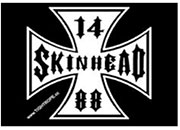
14/88 on a Nazi symbol
Description
14/88 is used as a neo-Nazi code to avoid the legal constraints in some countries that prohibit the display and use of symbols associated to Nazi Germany.
The number 14 refers to a 14-word slogan coined by the American Nazi David Lane, claiming that: "We must secure the existence of our people and a future for White Children". The 14 words has become a mantra for neo-Nazis.
The number 88 is the juxtaposition of two letters "H", representing the eighth letter of the alphabet, with "HH" standing for "Heil Hitler".
4/20

Adolf Hitler
Refers to the birthdate of Adolf Hitler, the 20th day of the 4th month (April 20).
23

White Pride Flag
Refers to the 23rd letter of the alphabet, the letter W for white. White supremacists also express this sign by making the numbers "2" and "3" with their fingers.
Rahowa
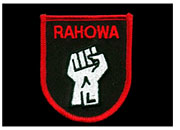
RaHoWa Symbol
Means Racial Holy War, a doctrine proclaimed by Ben Klassen of The Church of the Creator that is in line with the ideology of the group that considers white supremacy as a religion and its war as holy.

B/Left-wing Extremism
1. Groups, organizations and ideologies
Left-wing extremism is a vast political movement sharing a number of beliefs that reject capitalism, Western democracy as we know it, imperialism and militarism. These extreme beliefs, attitudes and positions are usually conveyed through a revolutionary discourse that can sometimes promote violence, often against the authorities, and even lead to acts of terrorism. Left-wing extremism draws its inspiration from the radical interpretation of different doctrines such as Maoism, Trotskyism, Castroism and Marxism-Leninism. Unlike right-wing extremists, leftists tend to be more discreet and maintain a low profile.
Reference
- Anonymous
- Black Bloc
- Anarchism
- Red and Anarchist Skinheads (RASH)
- Internationalist Resistance (IR) or Internationalist Resistance Initiative (IRI)
- Skinheads Against Racial Prejudice (SHARP)
Anonymous

Anonymous Symbol

A protester wearing a Guy Fawkes mask stands near the White House (USA)

Protesters at a anti-capitalist protest in Britain

Protesters at a anti-capitalist protest in Britain
Date of creation
2003
Classification
Activist for freedom of speech and equality, Anonymous is not an organization as such, but rather an ideology shared by many people, especially Internet users.
Description
The Anonymous movement defines itself as "hacktivist". Its members in the Web community launch anonymous attacks on the Internet. The word “hacktivist” is the fusion of "hacking" and "activist" and implies technological knowledge and political direct action. While the Anonymous ideology is known more for technological attacks, physical involvement in demonstrations is also considerable. At public events, supporters of the movement can be recognized by their distinctive mask representing Guy Fawkes who, in 1605, attempted to blow up the British parliament. The mask also refers to the movie "V for Vendetta" based on the graphic novel about the life of Guy Fawkes.
Anonymous claims to advocate freedom of speech, equality and other causes often related to current affairs. It was also actively involved in Wikileaks, a website created by hacker Julian Assange that discloses classified information from different countries.
Illegal or violent activities
Many large-scale attacks, ranging from the disclosure of personal emails coming from big corporations to the temporary closure of government sites, are claimed in the name of Anonymous. Anonymous Canada is known to have launched computer attacks against provincial and federal websites, rendering them temporarily inaccessible. For instance, between 2014 and 2015, the websites of the Parliament, the Supreme Court of Canada, the City of Ottawa, the Ottawa Police Service and the Service de Police de la Ville de Montréal were targeted by Anonymous. In 2014, Anonymous organized rallies in large cities worldwide, including in Canada, to commemorate the anniversary of the death of Guy Fawkes, on November 5.
+Reporting
- Canadian Cyber Incident Response Centre CCIRC: cyber-incident@ps-sp.gc.ca
- Government of Canada phone assistance: 1-800-O-Canada
- Public Safety Canada - Report a Cyber Security Incident
References
- La Presse - L'Équateur garantit à Assange l'asile "aussi longtemps que nécessaire" (in French)
- NationalPost.com - Toronto police website shut down in string of cyber attacks across Canada
- GlobalNews.ca - Canadian ‘hacktivists’ rally to support Anonymous on Guy Fawkes Day
Black Bloc
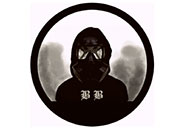
Black Bloc Illustration
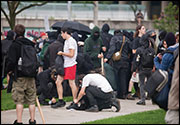
Anti G20 Protesters, thought to be part of the anarchist group the Black Bloc in the streets of Toronto, Canada.
Date of creation
1970s-1980s
Classification
Anti-capitalist. Not an organization, but an urban demonstration tactic
Description
The origin of this anarchist movement dates back to the 1970s-1980s. It started with groups of individuals advocating the reunification of Germany. The name Black Bloc was given by East Germany's political police (Stasi). Later, the Black Bloc movement evolved into an anti-capitalist movement as well as an alterglobalist and libertarian movement.
The Black Bloc is a tactic used by individuals to make themselves difficult to identify at demonstrations. Characterized by head-to-toe black clothing, the objective of the Black Bloc is to create an anonymous crowd to face the police. During demonstrations, the actions of the group are directly targeted at leading figures of capitalism in our society. These activists are sometimes involved in heated altercations with the police, considered by the movement as the armed branch of capitalism.
Variations of the Black Bloc movement are generally shortlived and mobilize through social media to demonstrate at major events.
Illegal or violent activities
The Black Bloc is often involved in the destruction of property owned by national companies and banks, as well as public property. The presence of the Black Bloc was observed in a number of demonstrations in Canada, including the 2001 Summit of the Americas in Québec City, the G20 Summit in Toronto in 2010 and the demonstration against police brutality on March 15, 2012 in Montréal. Not every group present at demonstrations agree with the Black Block. The extremist and relatively violent behaviour of the Black Bloc can create tension among demonstrators.
Reference
- LeDevoir.com - Black Bloc et carré rouge (French only)
Anarchism
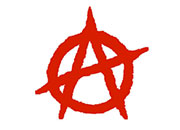
Symbol of anarchism

Demonstration against the Aéroport du Grand Ouest Project (France), fire caused by Anarchist.

Anarchist activists hold banners during an anti-G8 rally in Paris.

Anarchist activists hold banners during an anti-G8 rally in Paris.
Date of creation
Ideological current from the 19th Century
Classification
Anti-capitalist, anti-authority
Description
Anarchism is a philosophical current that is opposed to all forms of political authority. There are several variations of anarchism, some violent and others not. This anti-authority ideology conception is not synonymous with social unrest, but advocates an anti-capitalist order. There are numerous currents associated to anarchism and many groups use the anarchist symbols and beliefs to promote their ideology.
Illegal or violent activities
In 2010, an anarchist group called Southern Ontario Anarchist Resistance (SOAR) attacked a branch of the Royal Bank of Canada (RBC) during the G20 Summit in Toronto. The group claimed that the 2010 Vancouver Olympics were held on indigenous land stolen by the Government and blamed the bank for sponsoring the Games.
Reference
Red and Anarchist Skinheads (RASH)

Red and Anarchist Skinheads logo
Date of creation
1993
Classification
Anarchist, anti-fascist, anti-capitalist, pro-freedom
Description
Red and Anarchist Skinheads (RASH) is an extreme left-wing organization influenced by anarchism. Anti-fascism, anticapitalism and libertarian ideology are all fights carried out by RASH. They are represented by three arrows on the group’s logo. The movement was created in New York City. It is officially present in Canada since 1994.
Illegal or violent activities
The group carries out a never-ending fight through direct action against neo-Nazi skinheads (or boneheads as they are called by left-wing skinheads).
Reference
- Schweizer, Daniel (director). Skinhead Attitude [documentary], Switzerland, 2003.
Internationalist Resistance (IR) or Internationalist Resistance Initiative (IRI)

In 2010, the Internationalist Resistance claimed responsibility for a bomb attack against the Armed Forces Recruitment Centre in Trois-Rivières, Quebec.
Date of creation
Unknown, but first claim of responsibility in 2004
Classification
Anti-militarist, socialist, pro-environment
Description
The Internationalist Resistance (IR), previously known as the Internationalist Resistance Initiative (IRI), is an extremist anti-capitalist group. The environmentalist, anti-militarist and anti-American convictions of the group are expressed through overt radicalism.
Illegal or violent activities
From 2004 to 2010, this extremist group claimed responsibility for three bombings, including the bombing of a Hydro-Québec tower in Quebec Eastern Townships in 2004. The objective of this action was to jeopardize the transmission of electricity produced in Quebec to the United States, denouncing it as "(…) the 'pillaging' of Quebec's resources for the benefit of the American Empire".
In 2006, the radical group launched an attack against the vehicle of the Vice-President and Quebec spokesperson of the Canadian Petroleum Products Institute, Eastern Division. The IR claimed responsibility for the attack to denounce the profits maide by the oil industry and the war in Iraq. In 2010, the group bombed a Canadian Forces recruitment centre located in Trois-Rivières, Quebec. The group issued a communiqué stating that it was opposed to "the militaristic practices and ideals of the Canadian state".
Reference
Skinheads Against Racial Prejudice (SHARP)
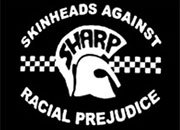
SHARP logo
Date of creation
1987
Classification
Anti-fascist, anti-racist
Description
Skinheads Against Racial Prejudice (SHARP) is a movement dedicated to fighting all forms of racism and decrying extreme right skinheads. SHARP rejects the use of the name skinhead by extreme right-wing neo-Nazis. Created in New York City in the late 1980s, SHARP recognizes the multiethnic roots of the skinhead sub-culture that was first observed in Great-Britain in the late 1960s. The movement has no political affiliation and is strongly committed to antifascism and anti-racism. The movement is present in Canada, mainly in Montréal, Toronto, Vancouver and southern Ontario. SHARP cannot be defined as a group of individuals, but rather as an informal network, with no official spokesperson and with the objective of bringing together all the extreme left-wing skinheads.
Illegal or violent activities
SHARP is not only present at counter neo-Nazi demonstrations where violence between demonstrators often occurs, but is also often involved in altercations with fascist groups. SHARP also engages in "Facho Watching", which consists in identifying far-right extremists and combatting them.
References
- Schweizer, Daniel (director). Skinhead Attitude [documentary], Switzerland, 2003.
- Campana, Aurélie and Samuel Tanner. The Process of Radicalization: Right-Wing Skinheads in Quebec, TSAS Working Paper, 2014.
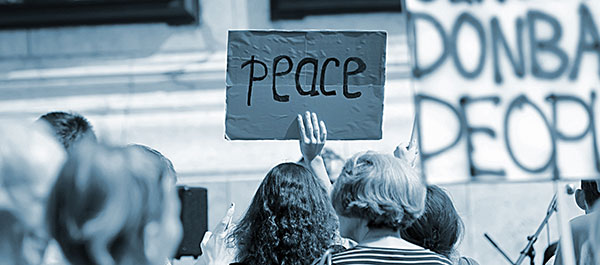
C/Sole motivation
1. Groups, organizations and ideologies
This category encompasses groups that are neither associated with to left-wing extremism nor right-wing extremism. These groups are motivated by a specific cause, such as the protection of the environment, the defense of certain rights or the abolition of certain laws.
Animal Liberation Front (ALF)
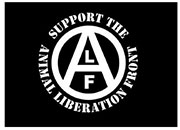
Animal Liberation Front logo
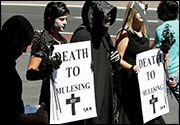
Members of the group Animal Liberation Front, one dressed as the 'Grim Reaper' and two as Ladies of Death walk through Sydney
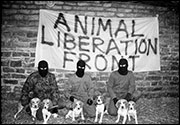
Protestors from the Animal Liberation Front
Date of creation
1976
Classification
Activist for animal rights. Not an organization per se, but rather a platform.
Description
The Animal Liberation Front (ALF) is an international movement that brings together activists resorting to direct action (e.g.: destruction of property and equipment) to fight for animal rights.
Illegal or violent activities
The organization often engages in illegal actions to promote its convictions and is therefore considered as a terrorist group by some governments. The organization rescues and liberates animals, but also carries out acts of vandalism by destructing equipment and property.
According to the FBI, the Animal Liberation Front (ALF) and its environmental equivalent, the Earth Liberation Front (ELF), have perpetrated over 1,100 criminal acts on American soil only, with damages amounting to more than a hundred million dollars. Among the FBI’s most wanted individuals, Joseph Mahmoud Dibee and Josephine Sunshine Overaker, both members of a group called The Family affiliated to ALF and ELF, are wanted for $48 million in damages, including $26 million for and attack against the Vail Ski Resort in 1998.
In Quebec, in 2008 and 2014, several thousand minks from a fur farm were liberated by anti-fur activists as was done in British-Columbia in 2013. In Canada, members of this organization have also attacked hunters. In 2014, the group injected butyric acid into the office of the Canadian Association for Laboratory Animal Science (CALAS) in Toronto.
References
- LePoint.fr - Végans extrémistes : Alex, cadre bancaire, marqué comme une bête
- Fbi.gov - Testimony - Testimony on Animal Rights Extremism and Ecoterrorism (archive)
- Zone libre, Radio-Canada.ca - Le Front de libération des animaux
Earth Liberation Front (ELF)

Earth Liberation Front logo
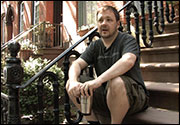
Daniel McGowan was sentenced to seven years in prison for his activities with the radical Earth Liberation Front.
Date of creation
1996
Classification
Ecologist
Description
The Earth Liberation Front (ELF) is an international ecologist movement created in England. The extremist group uses radical means to stop the exploitation and destruction of the environment. It is a resistance group with no official representative or leader. This tactic of having no official leader is used by numerous groups such as the Ku Klux Klan (KKK) to avoid being infiltrated by the authorities. The members, often called "Elves", share the same ideology and operate in cells, with no chain of command. Their only known spokesperson, the American Craig Rosebraugh, encouraged ALF and ELF members to use violent tactics and support conspiracy theories.
The Earth Liberation Front (ELF) and the Animal Liberation Front (ALF) still maintain their cooperation and link.
Illegal or violent activities
The Earth Liberation Front advocates direct action, including arson and vandalism, to support its convictions. ELF also resorts to sabotage or monkeywrenching, which consists in a range of actions such as graffiti on buildings and vehicles, the destruction of equipment, etc.
Rebecca Rubin, a Canadian ecologist activist of the ELF and ALF radical movement, who was wanted and described as an eco-terrorist by the United States, surrendered to the Washington State authorities in 2013. She pleaded guilty to charges of arson and conspiracy between 1997 and 2001 and was sentenced to five years in jail in January 2014. In 2003, ELF was involved in the destruction of a $23 million apartment complex in the San Diego area in the US.
References
- Leader, Stefan H. and Peter Probst. The Earth Liberation Front and Environmental Terrorism in Terrorism and Political Violence, Vol. 15, No. 4, 2010.
- NYTimes.com - The Face of Eco-Terrorism
- Macleans.ca - Rebecca Rubin’s day of reckoning
Freemen on the Land (FMOTL)

Freemen on the Land logo
Date of creation
The 1970s
Classification
Anti-government
Description
Freemen on the Land (FMOTL), or Sovereign Citizens, is an anarchist movement with extreme right tendencies. It was initiated in the United States and its adherents advocate the return to the values of the founding fathers of the United States, where the state and statute laws were less present. This movement is on the FBI’s domestic watchlist and is also present in Canada, Ireland and the United Kingdom.
FMOTL encourages different forms of rejection of the state, including by refusing to use driver’s licences, to register or insure their vehicles and to pay taxes. Some members also do not recognize the courts of law and refuse to be tried by them. They are categorized as "separatist" by a number of authors and it is believed that a manuscript known as the "Nehemiah Township Document and Common Law Contract" provides the foundation for separatist organizations. A religiously-based Republican government, in which only Aryan freemen would have rights, was the ultimate goal of the Nehemiah Township Charter. The slogan of certain freemen is "Think free, be free".
Illegal or violent activities
Many freemen were involved in provincial and federal offences, with some also involved in serious crimes. In 1995, in the United States, Terry Nichols was one of the terrorists involved in the Oklahoma City bombing against a FBI building that killed 168 people. The American authorities reported that since 2000, six police officers were killed by freemen. In 2015, a member of the Edmonton Police Hate Crimes Detail was killed by Norman Raddatz, an individual who demonstrated ideologies consistent with the FMOTL movement.
In the last few years, freemen filed liens on property owned by judges, both in the United States and Canada. This tactic was observed in 2012 in Quebec and British Columbia. There are also many cases, such as in Calgary in 2013, when a member of FMOTL, Andreas Pirelli, who after receiving an eviction order from the Court illegally confiscated the house of a retired woman and claimed the house as his "embassy". In Quebec, one of the members of the Citoyens souverains, the Quebec version of the Freemen on the Land, Jean-Marc Paquin, had his vehicle seized by the authorities for failing to make complete payment and was fined $27,000 for causing harm to the authorities.
Symbols associated to freemen include biblical references, postage stamps placed on documents, bar codes, fingerprints and blood seals. They also use different names in official documents to confuse the authorities.
References
- The Law Society of British Columbia - The Freeman-on-the-Land movement
- Baysinger, Timothy G. Right-Wing Group Characteristics and Ideology, Naval Postgraduate School Monterey, Center for Homeland Defense and Security, 2006.

